tow DODGE INTREPID 2004 2.G Owners Manual
[x] Cancel search | Manufacturer: DODGE, Model Year: 2004, Model line: INTREPID, Model: DODGE INTREPID 2004 2.GPages: 249, PDF Size: 4.87 MB
Page 22 of 249
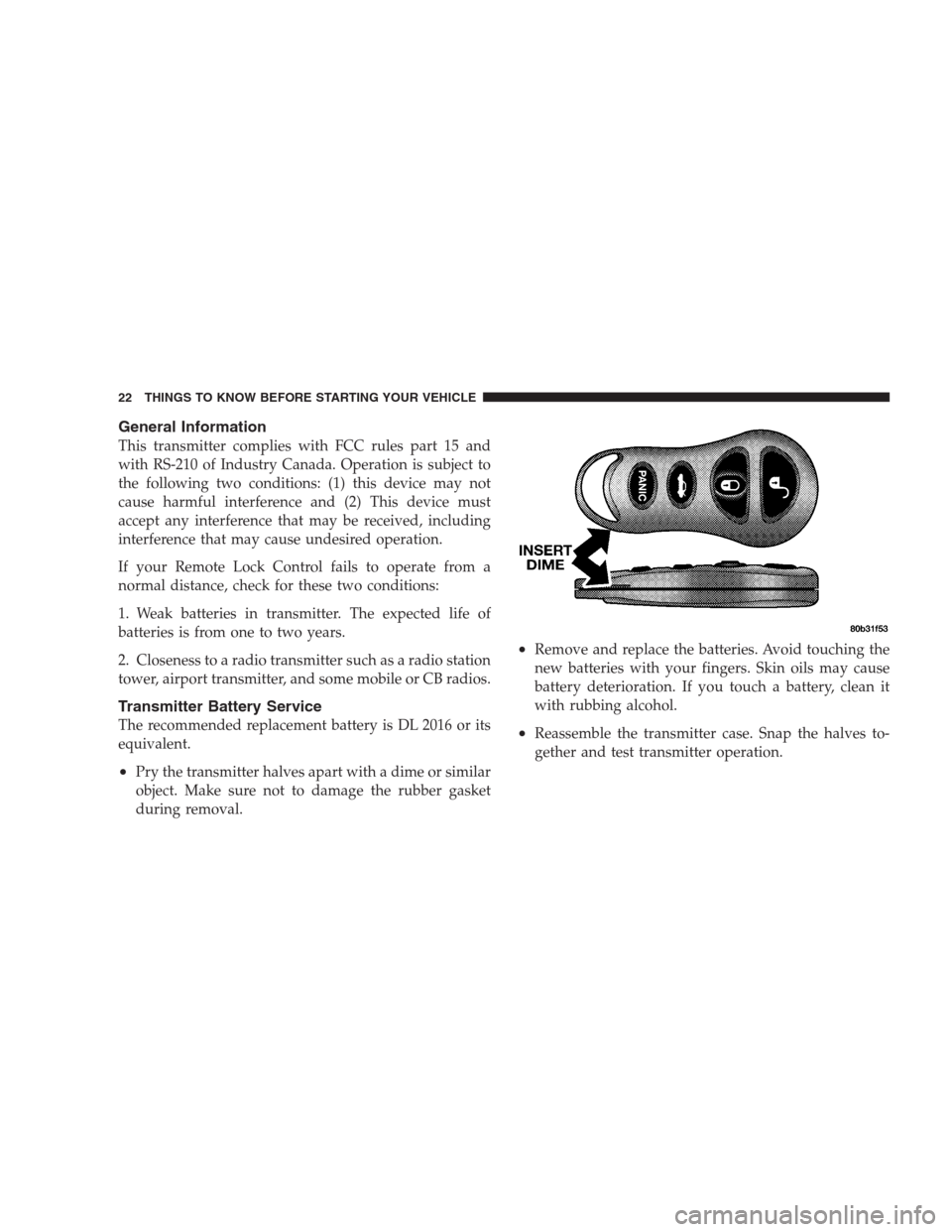
General Information
This transmitter complies with FCC rules part 15 and
with RS-210 of Industry Canada. Operation is subject to
the following two conditions: (1) this device may not
cause harmful interference and (2) This device must
accept any interference that may be received, including
interference that may cause undesired operation.
If your Remote Lock Control fails to operate from a
normal distance, check for these two conditions:
1. Weak batteries in transmitter. The expected life of
batteries is from one to two years.
2. Closeness to a radio transmitter such as a radio station
tower, airport transmitter, and some mobile or CB radios.
Transmitter Battery Service
The recommended replacement battery is DL 2016 or its
equivalent.
•Pry the transmitter halves apart with a dime or similar
object. Make sure not to damage the rubber gasket
during removal.
•Remove and replace the batteries. Avoid touching the
new batteries with your fingers. Skin oils may cause
battery deterioration. If you touch a battery, clean it
with rubbing alcohol.
•Reassemble the transmitter case. Snap the halves to-
gether and test transmitter operation.
22 THINGS TO KNOW BEFORE STARTING YOUR VEHICLE
Page 30 of 249
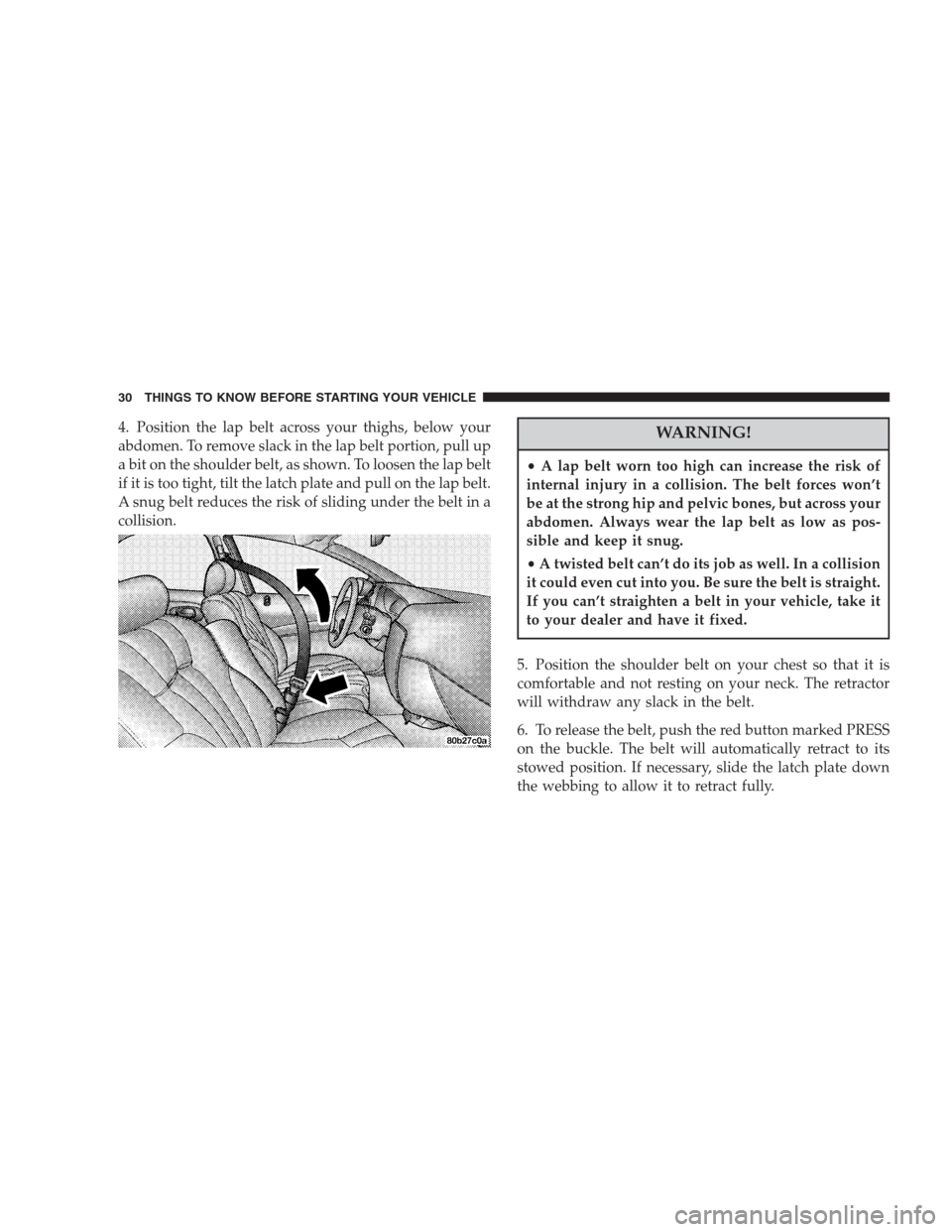
4. Position the lap belt across your thighs, below your
abdomen. To remove slack in the lap belt portion, pull up
a bit on the shoulder belt, as shown. To loosen the lap belt
if it is too tight, tilt the latch plate and pull on the lap belt.
A snug belt reduces the risk of sliding under the belt in a
collision.WARNING!
•A lap belt worn too high can increase the risk of
internal injury in a collision. The belt forces won’t
be at the strong hip and pelvic bones, but across your
abdomen. Always wear the lap belt as low as pos-
sible and keep it snug.
•A twisted belt can’t do its job as well. In a collision
it could even cut into you. Be sure the belt is straight.
If you can’t straighten a belt in your vehicle, take it
to your dealer and have it fixed.
5. Position the shoulder belt on your chest so that it is
comfortable and not resting on your neck. The retractor
will withdraw any slack in the belt.
6. To release the belt, push the red button marked PRESS
on the buckle. The belt will automatically retract to its
stowed position. If necessary, slide the latch plate down
the webbing to allow it to retract fully.
30 THINGS TO KNOW BEFORE STARTING YOUR VEHICLE
Page 31 of 249
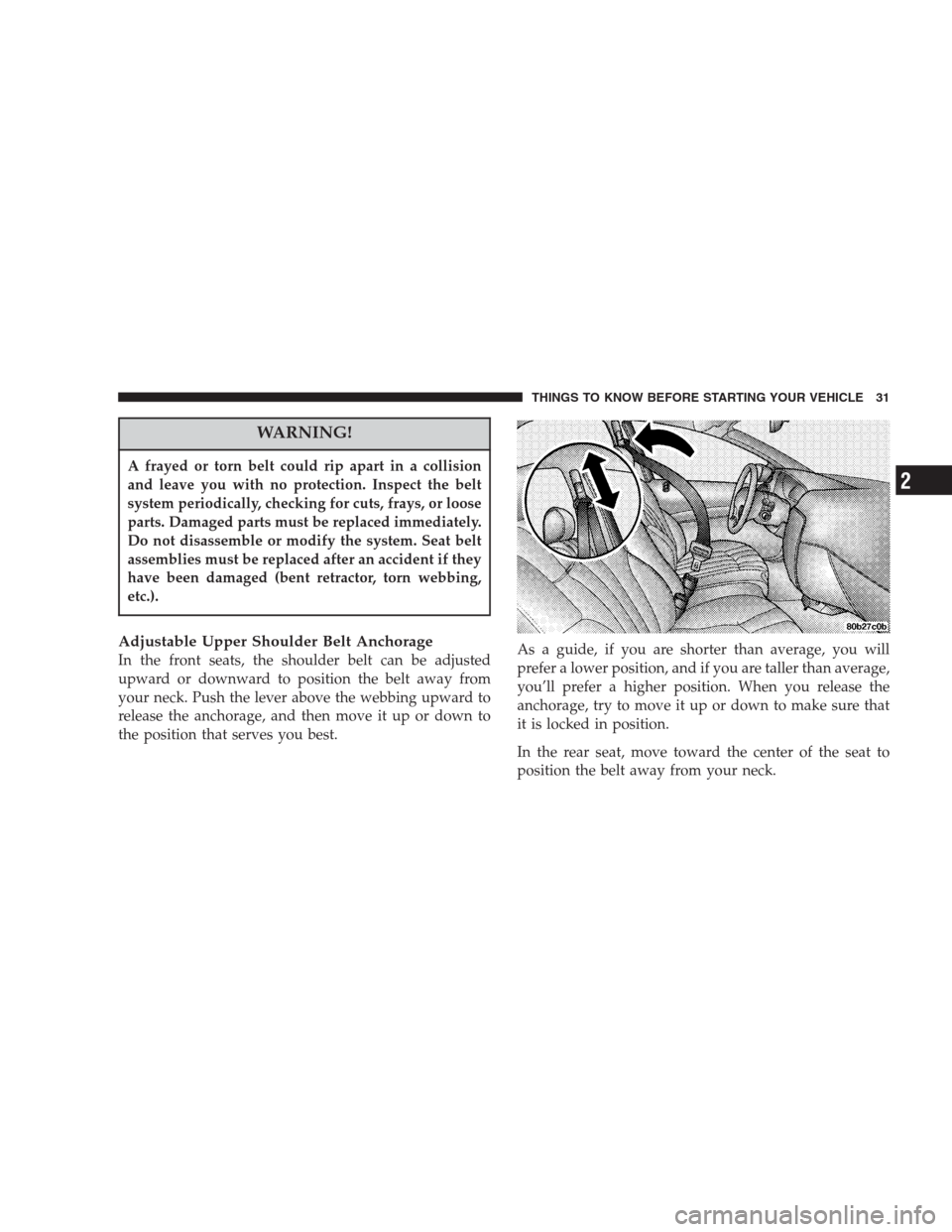
WARNING!
A frayed or torn belt could rip apart in a collision
and leave you with no protection. Inspect the belt
system periodically, checking for cuts, frays, or loose
parts. Damaged parts must be replaced immediately.
Do not disassemble or modify the system. Seat belt
assemblies must be replaced after an accident if they
have been damaged (bent retractor, torn webbing,
etc.).
Adjustable Upper Shoulder Belt Anchorage
In the front seats, the shoulder belt can be adjusted
upward or downward to position the belt away from
your neck. Push the lever above the webbing upward to
release the anchorage, and then move it up or down to
the position that serves you best.As a guide, if you are shorter than average, you will
prefer a lower position, and if you are taller than average,
you’ll prefer a higher position. When you release the
anchorage, try to move it up or down to make sure that
it is locked in position.
In the rear seat, move toward the center of the seat to
position the belt away from your neck.
THINGS TO KNOW BEFORE STARTING YOUR VEHICLE 31
2
Page 37 of 249
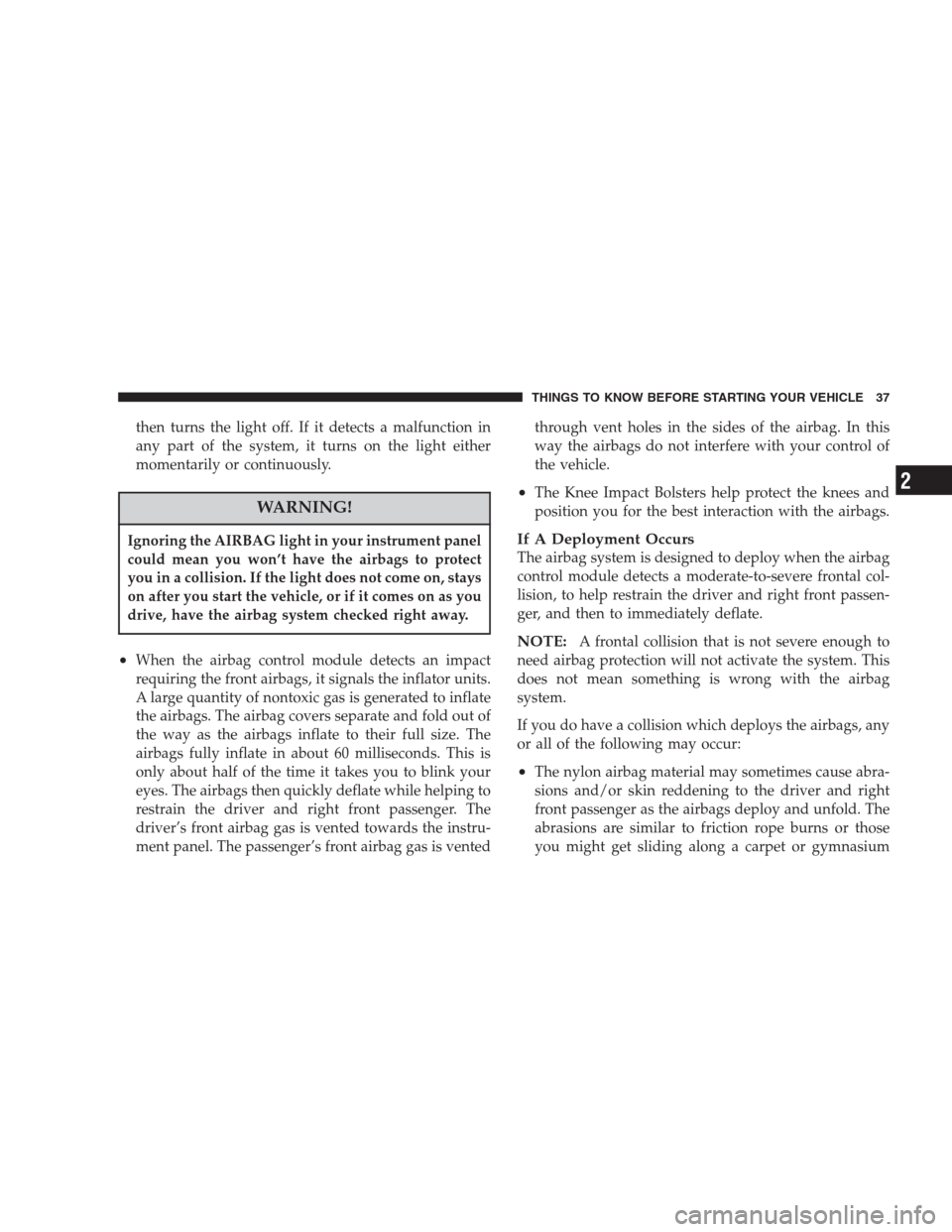
then turns the light off. If it detects a malfunction in
any part of the system, it turns on the light either
momentarily or continuously.
WARNING!
Ignoring the AIRBAG light in your instrument panel
could mean you won’t have the airbags to protect
you in a collision. If the light does not come on, stays
on after you start the vehicle, or if it comes on as you
drive, have the airbag system checked right away.
•When the airbag control module detects an impact
requiring the front airbags, it signals the inflator units.
A large quantity of nontoxic gas is generated to inflate
the airbags. The airbag covers separate and fold out of
the way as the airbags inflate to their full size. The
airbags fully inflate in about 60 milliseconds. This is
only about half of the time it takes you to blink your
eyes. The airbags then quickly deflate while helping to
restrain the driver and right front passenger. The
driver’s front airbag gas is vented towards the instru-
ment panel. The passenger’s front airbag gas is ventedthrough vent holes in the sides of the airbag. In this
way the airbags do not interfere with your control of
the vehicle.
•The Knee Impact Bolsters help protect the knees and
position you for the best interaction with the airbags.
If A Deployment Occurs
The airbag system is designed to deploy when the airbag
control module detects a moderate-to-severe frontal col-
lision, to help restrain the driver and right front passen-
ger, and then to immediately deflate.
NOTE:A frontal collision that is not severe enough to
need airbag protection will not activate the system. This
does not mean something is wrong with the airbag
system.
If you do have a collision which deploys the airbags, any
or all of the following may occur:
•The nylon airbag material may sometimes cause abra-
sions and/or skin reddening to the driver and right
front passenger as the airbags deploy and unfold. The
abrasions are similar to friction rope burns or those
you might get sliding along a carpet or gymnasium
THINGS TO KNOW BEFORE STARTING YOUR VEHICLE 37
2
Page 53 of 249
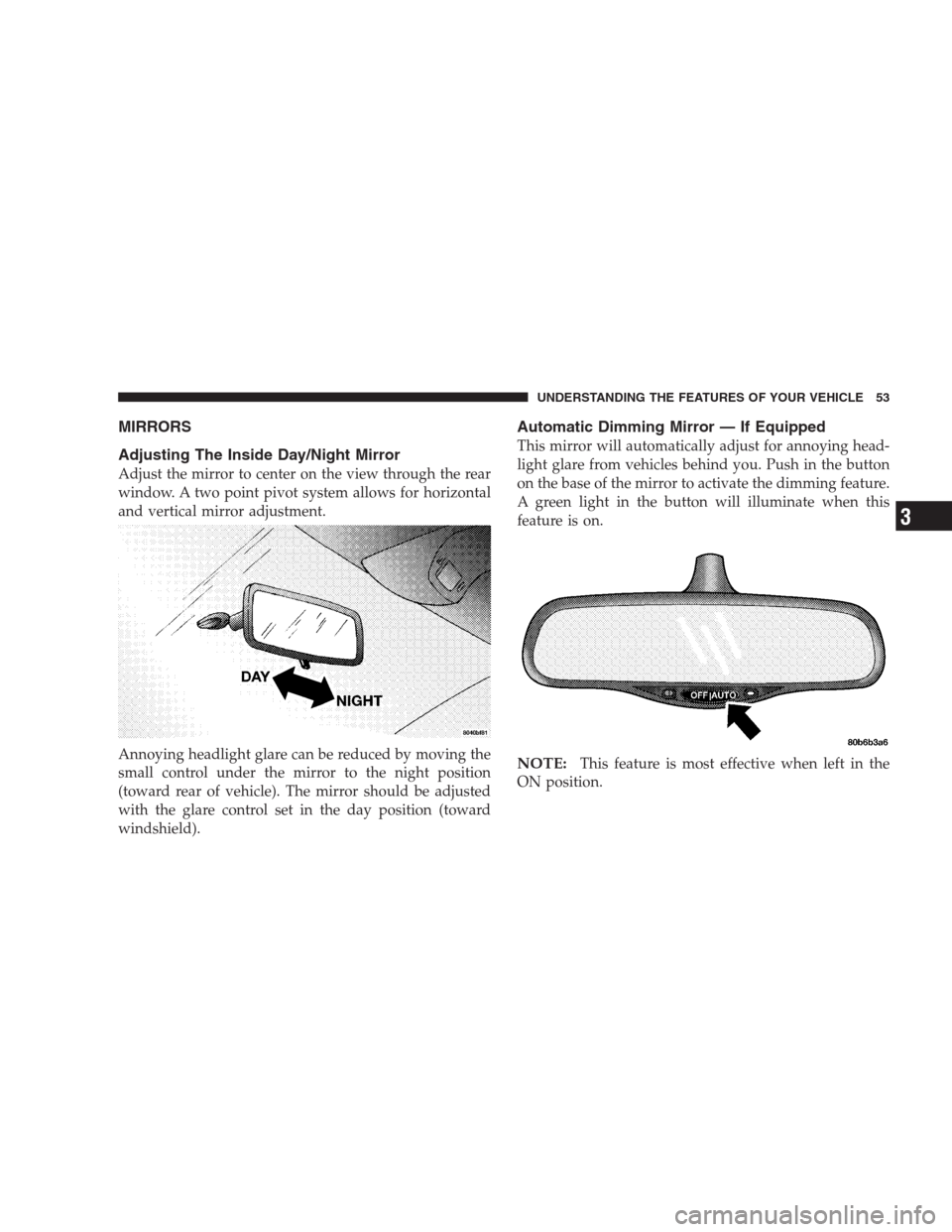
MIRRORS
Adjusting The Inside Day/Night Mirror
Adjust the mirror to center on the view through the rear
window. A two point pivot system allows for horizontal
and vertical mirror adjustment.
Annoying headlight glare can be reduced by moving the
small control under the mirror to the night position
(toward rear of vehicle). The mirror should be adjusted
with the glare control set in the day position (toward
windshield).
Automatic Dimming Mirror — If Equipped
This mirror will automatically adjust for annoying head-
light glare from vehicles behind you. Push in the button
on the base of the mirror to activate the dimming feature.
A green light in the button will illuminate when this
feature is on.
NOTE:This feature is most effective when left in the
ON position.
UNDERSTANDING THE FEATURES OF YOUR VEHICLE 53
3
Page 64 of 249
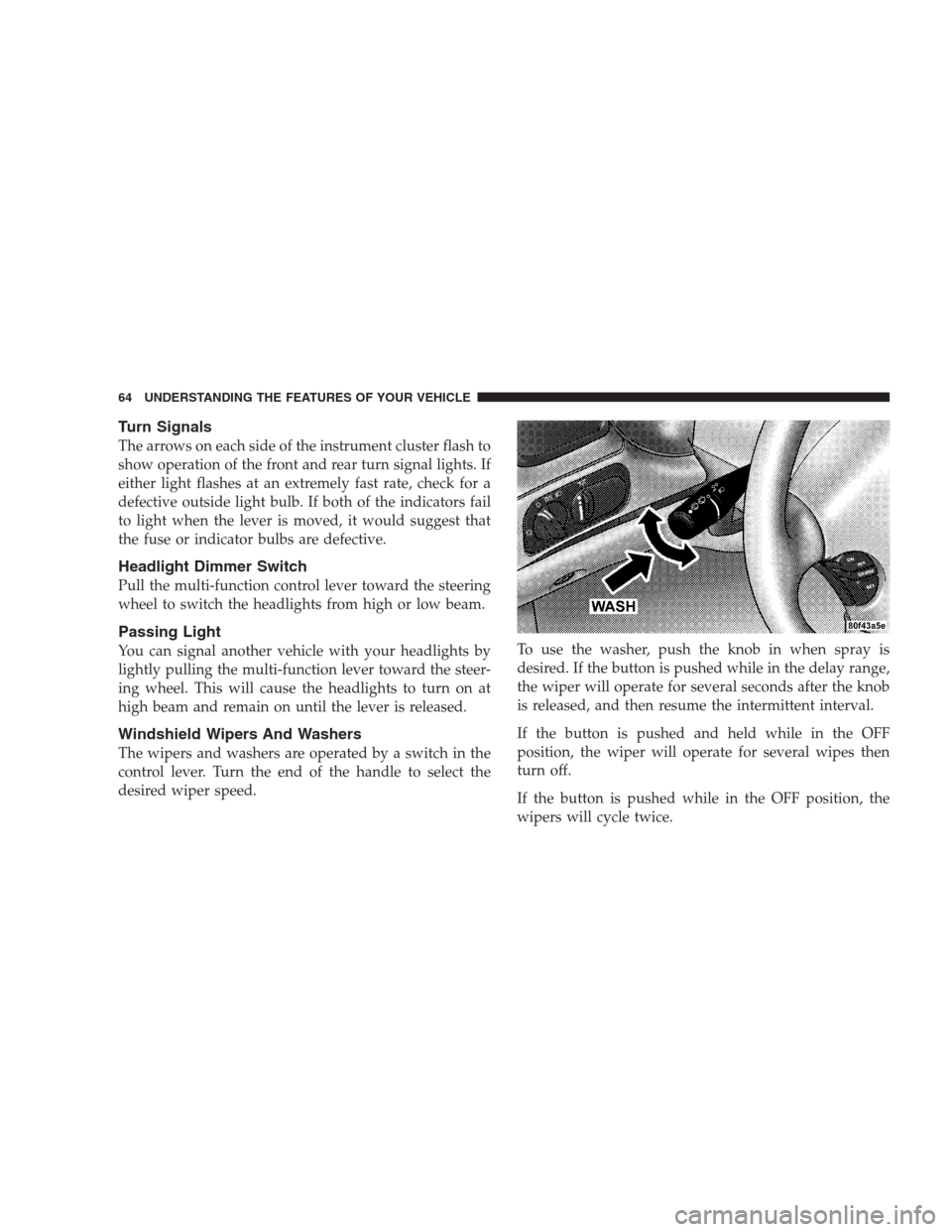
Turn Signals
The arrows on each side of the instrument cluster flash to
show operation of the front and rear turn signal lights. If
either light flashes at an extremely fast rate, check for a
defective outside light bulb. If both of the indicators fail
to light when the lever is moved, it would suggest that
the fuse or indicator bulbs are defective.
Headlight Dimmer Switch
Pull the multi-function control lever toward the steering
wheel to switch the headlights from high or low beam.
Passing Light
You can signal another vehicle with your headlights by
lightly pulling the multi-function lever toward the steer-
ing wheel. This will cause the headlights to turn on at
high beam and remain on until the lever is released.
Windshield Wipers And Washers
The wipers and washers are operated by a switch in the
control lever. Turn the end of the handle to select the
desired wiper speed.To use the washer, push the knob in when spray is
desired. If the button is pushed while in the delay range,
the wiper will operate for several seconds after the knob
is released, and then resume the intermittent interval.
If the button is pushed and held while in the OFF
position, the wiper will operate for several wipes then
turn off.
If the button is pushed while in the OFF position, the
wipers will cycle twice.
64 UNDERSTANDING THE FEATURES OF YOUR VEHICLE
Page 65 of 249
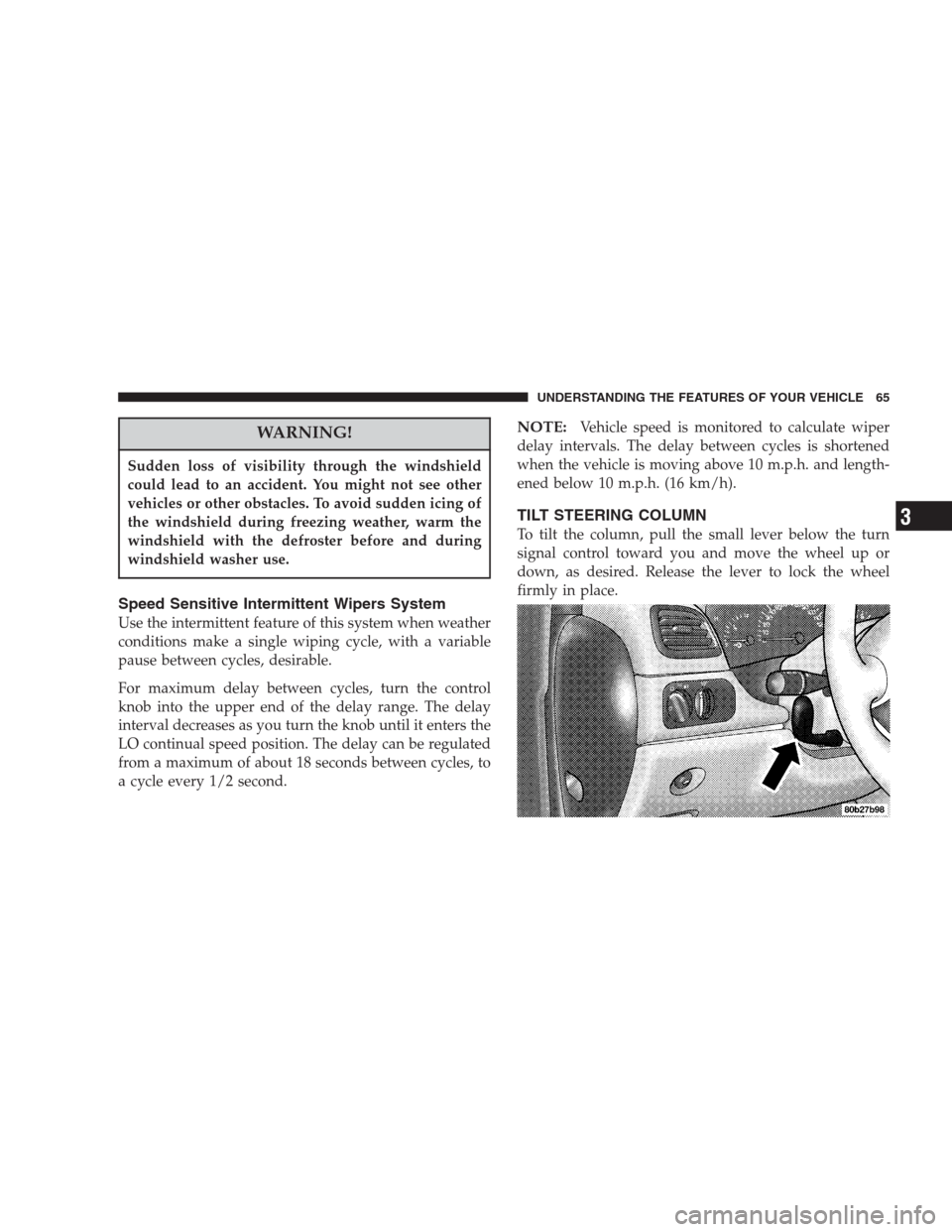
WARNING!
Sudden loss of visibility through the windshield
could lead to an accident. You might not see other
vehicles or other obstacles. To avoid sudden icing of
the windshield during freezing weather, warm the
windshield with the defroster before and during
windshield washer use.
Speed Sensitive Intermittent Wipers System
Use the intermittent feature of this system when weather
conditions make a single wiping cycle, with a variable
pause between cycles, desirable.
For maximum delay between cycles, turn the control
knob into the upper end of the delay range. The delay
interval decreases as you turn the knob until it enters the
LO continual speed position. The delay can be regulated
from a maximum of about 18 seconds between cycles, to
a cycle every 1/2 second.
NOTE:Vehicle speed is monitored to calculate wiper
delay intervals. The delay between cycles is shortened
when the vehicle is moving above 10 m.p.h. and length-
ened below 10 m.p.h. (16 km/h).
TILT STEERING COLUMN
To tilt the column, pull the small lever below the turn
signal control toward you and move the wheel up or
down, as desired. Release the lever to lock the wheel
firmly in place.
UNDERSTANDING THE FEATURES OF YOUR VEHICLE 65
3
Page 89 of 249
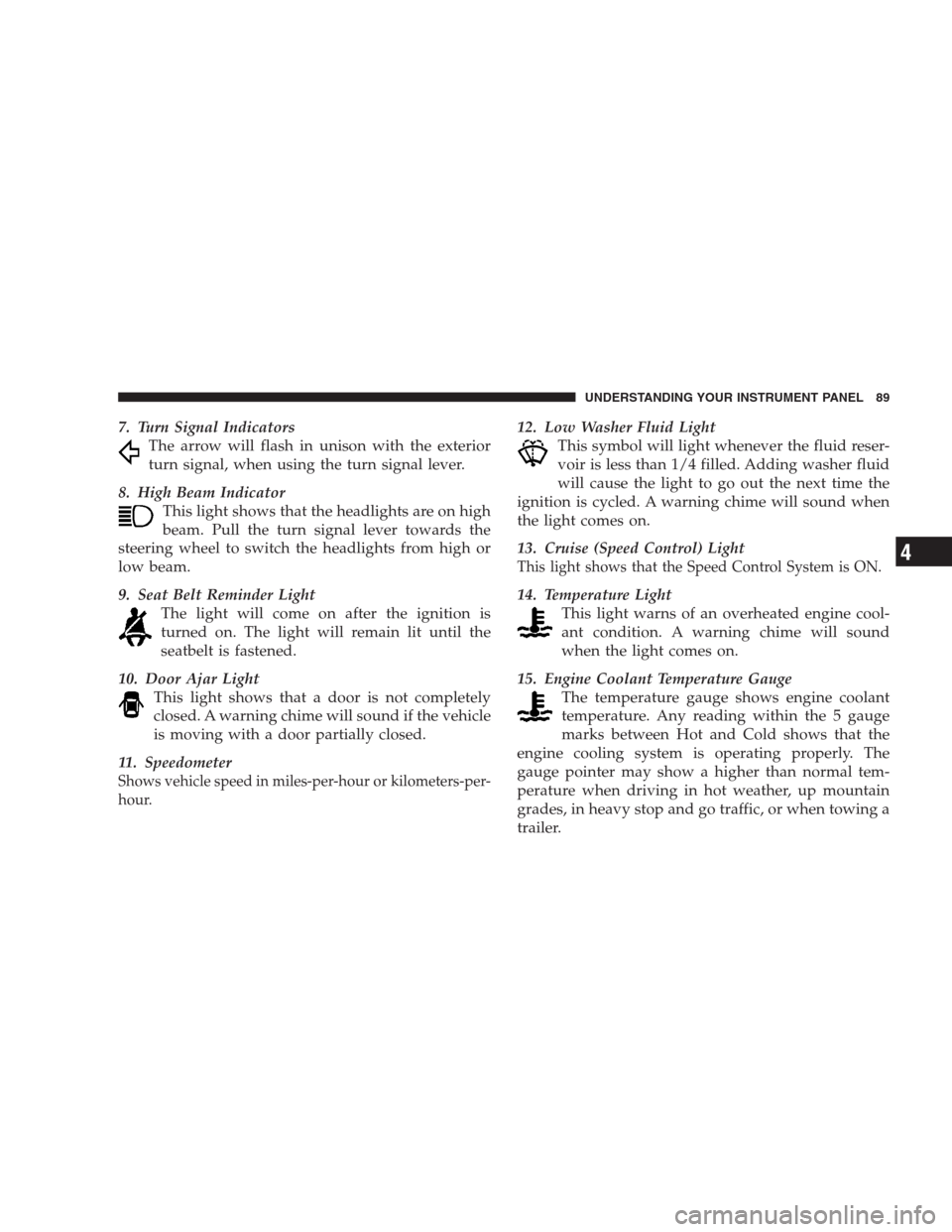
7. Turn Signal Indicators
The arrow will flash in unison with the exterior
turn signal, when using the turn signal lever.
8. High Beam Indicator
This light shows that the headlights are on high
beam. Pull the turn signal lever towards the
steering wheel to switch the headlights from high or
low beam.
9. Seat Belt Reminder Light
The light will come on after the ignition is
turned on. The light will remain lit until the
seatbelt is fastened.
10. Door Ajar Light
This light shows that a door is not completely
closed. A warning chime will sound if the vehicle
is moving with a door partially closed.
11. Speedometer
Shows vehicle speed in miles-per-hour or kilometers-per-
hour.
12. Low Washer Fluid Light
This symbol will light whenever the fluid reser-
voir is less than 1/4 filled. Adding washer fluid
will cause the light to go out the next time the
ignition is cycled. A warning chime will sound when
the light comes on.
13. Cruise (Speed Control) Light
This light shows that the Speed Control System is ON.
14. Temperature Light
This light warns of an overheated engine cool-
ant condition. A warning chime will sound
when the light comes on.
15. Engine Coolant Temperature Gauge
The temperature gauge shows engine coolant
temperature. Any reading within the 5 gauge
marks between Hot and Cold shows that the
engine cooling system is operating properly. The
gauge pointer may show a higher than normal tem-
perature when driving in hot weather, up mountain
grades, in heavy stop and go traffic, or when towing a
trailer.
UNDERSTANDING YOUR INSTRUMENT PANEL 89
4
Page 90 of 249
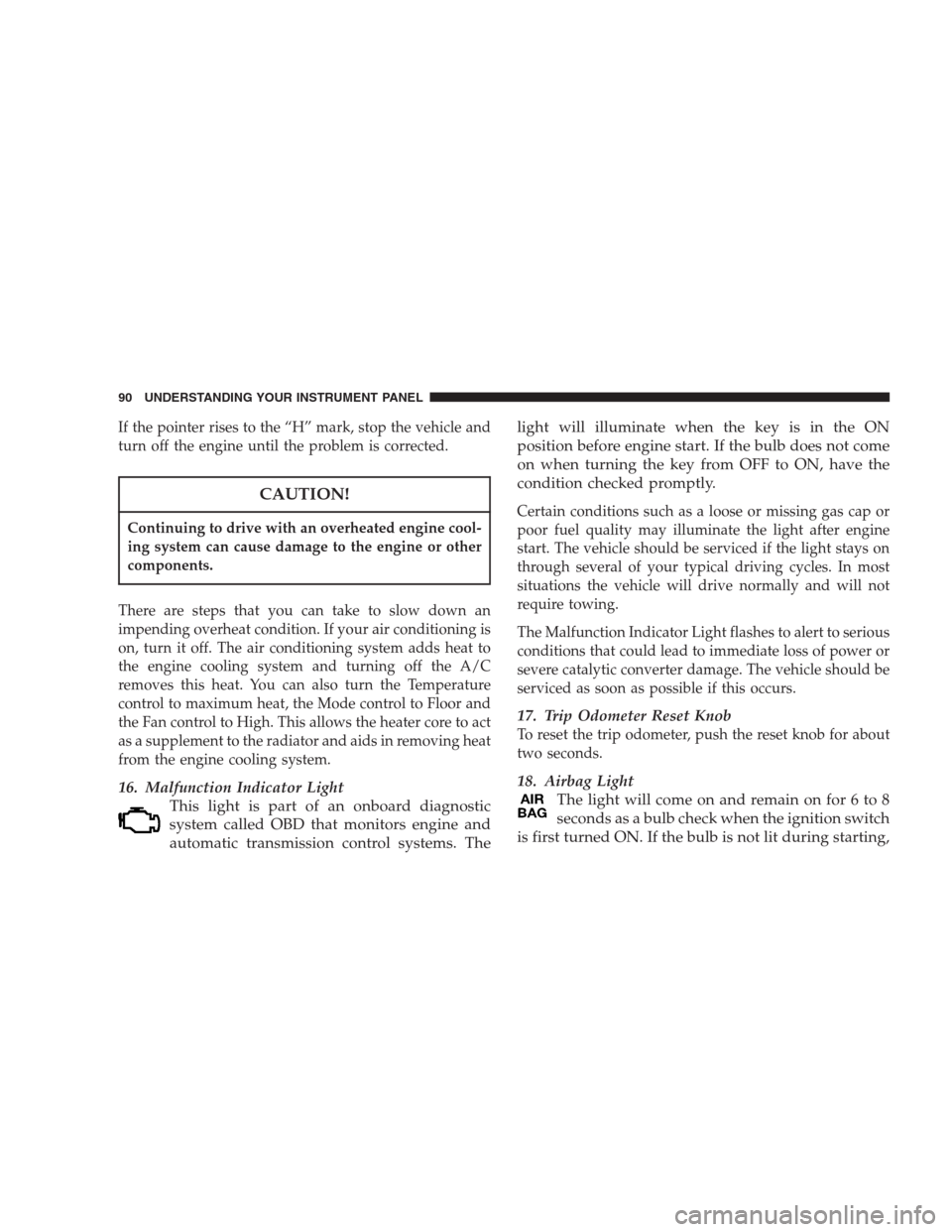
If the pointer rises to the “H” mark, stop the vehicle and
turn off the engine until the problem is corrected.
CAUTION!
Continuing to drive with an overheated engine cool-
ing system can cause damage to the engine or other
components.
There are steps that you can take to slow down an
impending overheat condition. If your air conditioning is
on, turn it off. The air conditioning system adds heat to
the engine cooling system and turning off the A/C
removes this heat. You can also turn the Temperature
control to maximum heat, the Mode control to Floor and
the Fan control to High. This allows the heater core to act
as a supplement to the radiator and aids in removing heat
from the engine cooling system.
16. Malfunction Indicator Light
This light is part of an onboard diagnostic
system called OBD that monitors engine and
automatic transmission control systems. Thelight will illuminate when the key is in the ON
position before engine start. If the bulb does not come
on when turning the key from OFF to ON, have the
condition checked promptly.
Certain conditions such as a loose or missing gas cap or
poor fuel quality may illuminate the light after engine
start. The vehicle should be serviced if the light stays on
through several of your typical driving cycles. In most
situations the vehicle will drive normally and will not
require towing.
The Malfunction Indicator Light flashes to alert to serious
conditions that could lead to immediate loss of power or
severe catalytic converter damage. The vehicle should be
serviced as soon as possible if this occurs.
17. Trip Odometer Reset Knob
To reset the trip odometer, push the reset knob for about
two seconds.
18. Airbag Light
The light will come on and remain on for 6 to 8
seconds as a bulb check when the ignition switch
is first turned ON. If the bulb is not lit during starting,
90 UNDERSTANDING YOUR INSTRUMENT PANEL
Page 96 of 249
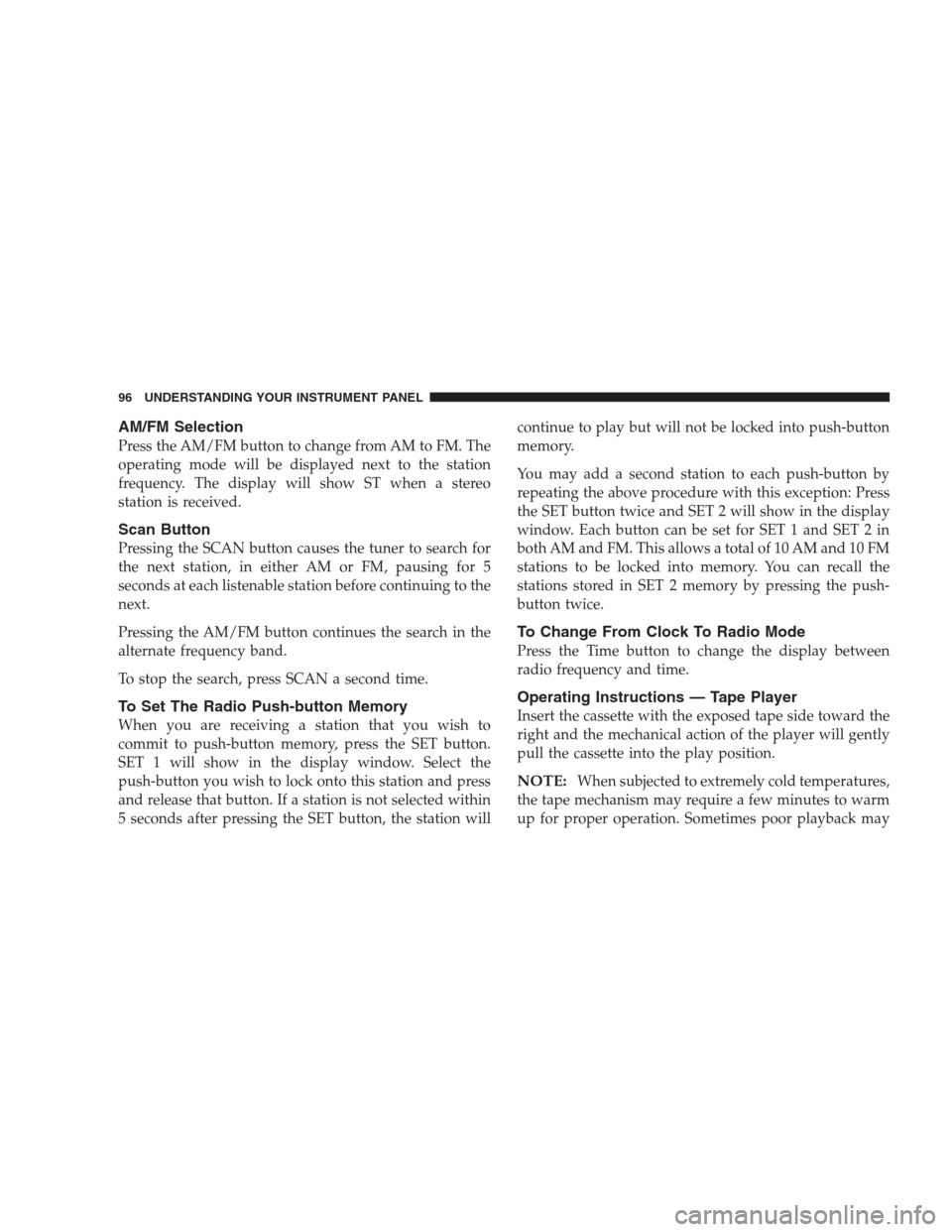
AM/FM Selection
Press the AM/FM button to change from AM to FM. The
operating mode will be displayed next to the station
frequency. The display will show ST when a stereo
station is received.
Scan Button
Pressing the SCAN button causes the tuner to search for
the next station, in either AM or FM, pausing for 5
seconds at each listenable station before continuing to the
next.
Pressing the AM/FM button continues the search in the
alternate frequency band.
To stop the search, press SCAN a second time.
To Set The Radio Push-button Memory
When you are receiving a station that you wish to
commit to push-button memory, press the SET button.
SET 1 will show in the display window. Select the
push-button you wish to lock onto this station and press
and release that button. If a station is not selected within
5 seconds after pressing the SET button, the station willcontinue to play but will not be locked into push-button
memory.
You may add a second station to each push-button by
repeating the above procedure with this exception: Press
the SET button twice and SET 2 will show in the display
window. Each button can be set for SET 1 and SET 2 in
both AM and FM. This allows a total of 10 AM and 10 FM
stations to be locked into memory. You can recall the
stations stored in SET 2 memory by pressing the push-
button twice.
To Change From Clock To Radio Mode
Press the Time button to change the display between
radio frequency and time.
Operating Instructions — Tape Player
Insert the cassette with the exposed tape side toward the
right and the mechanical action of the player will gently
pull the cassette into the play position.
NOTE:When subjected to extremely cold temperatures,
the tape mechanism may require a few minutes to warm
up for proper operation. Sometimes poor playback may
96 UNDERSTANDING YOUR INSTRUMENT PANEL